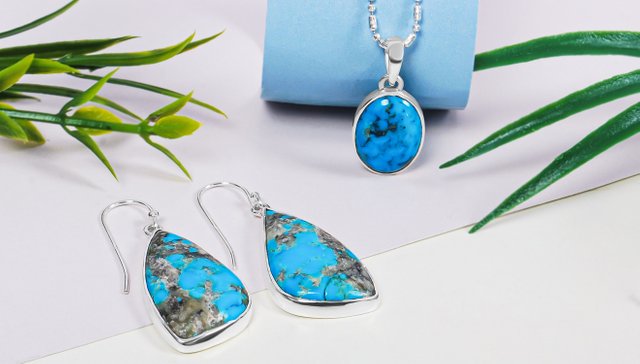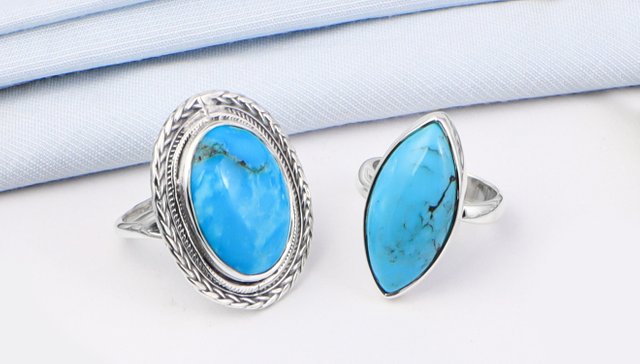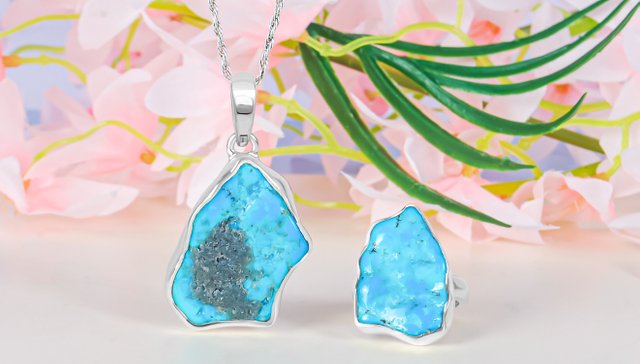
A fragile semi-precious gemstone, Turquoise is one of history's most adorned pieces and symbolically suffused gems. Prized for thousands of years, it was believed to be one of the most important gemstones intentionally mined. In America, Turquoise moved between mining areas in present-day New Mexico through different trading networks and was comprehended into the range of objects known as Aztec mosaics.
The Increasing demand for a truly astounding turquoise from the Meso American world arguably led to its popularity in the Southwestern United States, making it a center attraction. In addition, the areas of New Mexico and California were mined by Native Americans using stone tools, building up the heritage of Turquoise as a symbol and ornament within Native American cultures.
As a result, expansion from west of United States, turquoise mining reached its heights in the late-19th century but was unexpectedly impeded by the onset of the Great Depression in the 1930s. However, a compelling source of Turquoise can still be found in the areas of California, Colorado, Arizona, New Mexico, and Nevada. But in recent times, only one mine, located in Apache Canyon, California, commercially operates today.
Turquoise Jewelry In The Past
For over the centuries, jewelry and its talismans have been made from eloquent turquoise stones. These stones have proved fascinating for cultures worldwide. For early known civilizations such as the Ancient Egyptians, Chinese (more than3,000 years ago), Persians, and Aztecs, Turquoise was a prized material with spiritual and political value.
Early Use
The widespread use of Turquoise was seen in Mesoamerica in the 3rd century. It became widely used around the 10th century in ideological significance. The material was used in ceremonies, ornaments, and decorations by the kings and priests to bring the rain, fertility, and maize.
The term 'turquoise' was originated from the French word Pierre torques and reflected how the gem first reached Europe through Turkish trade routes during the 11th century. The gem was extensively used during the Middle Ages as a talisman and was seen and admired as a fashion item from the 17th century. In that particular century, it got highlighted and people started admiring turquoise jewelry. In the 19th century, Queen Victorian re- established Turquoise as a symbol of true love and cherished it wholeheartedly. This hype lead to a surge in the stone's popularity across Europe.

Turquoise was also used by the famous Art Deco jewelers. Later in the 1960s and 1970s, they were widely used for statement pieces combined with diamonds and Turquoise in the yellow diamond, giving birth to jewelry such as turquoise rings and earrings.
Turquoise Jewelry in Native American
Today the Turquoise is linked with Native American heritage. With a rich tradition of creating turquoise jewelry and carving it for at least 140 years, this stone was particularly important within Pueblo, Hopi, and Apache cultures. First, it was widely used for its ceremonial and "protective" traits.
Later with the subsequent development of new artisan and silversmithing techniques, this regular gemstone piece was used in a distinctive combination of silver and Turquoise, making the jewelry pieces like turquoise bracelets and pendants the people loved.
Today, the mass production of low-quality Turquoise has distorted the value associated with the material. Therefore, this stone's quality is one of the most important factors when determining the value of a piece of turquoise jewelry.
Fact: Prices for mature turquoise jewelry at auction can range from hundreds to thousands of dollars.
Present-day Designs
In the modern era, with the increasing demand, the designers started experimenting with Turquoise. These pieces became popular at auction, and the designers like Gail Bird, Yazzie Johnson, and Charles Loloma got the most highlight. They eventually bought forward the art of contemporary Native American jewelry, making it the talk of the town.
The Japanese grew sudden interest in American turquoise jewelry and rekindled connoisseurship with interest in vintage turquoise jewelry from the 1970s. In addition, antique Persian jewelry featuring carved Turquoise inlaid with gold also got many highlights.
Types of Turquoise
There are different types of Turquoise in the market. Some of these turquoises require some degree of treatment to make the stones durable enough to form in the beautiful pieces of turquoise earrings and pendants.
* The most suitable: Natural Turquoise
Generally, this type of Turquoise doesn't require any treatment or is naturally flawless to be used by jewelry-makers. Therefore, this gem is the most desirable and valuable type of Turquoise, especially when it bears an intense color.
* Stabilized Turquoise
The most commonly used Turquoise in jewelry market is the Stabilized Turquoise. However, this type of coarse Turquoise is usually too soft and fragile for manufacturing. Therefore, it is often treated by infiltrating a polymer or other binding material to make it suitable to cut into pieces.
* Composite Turquoise
The gem, otherwise known as "block turquoise," composite or reconstructed. Is made from small turquoise pieces mixed with a polymer and cast into block-shaped pieces. To achieve the texture, finely crushed Turquoise and non-turquoise materials are combined to strengthen the material. This type of Turquoise is called man-made and makes beautiful jewelry pieces.
* Dyed Turquoise
This particular type of Turquoise is often regarded as composite and reconstituted Turquoise, which is porous and can easily absorb any dyes.
Turquoise Color

Turquoise hues can range from opaque to semi-translucent, with a waxy to a dull appearance. These tones are determined by iron and copper content in the stone, making the different shades from blue to deep blue and from blue-green to yellow-green, with the most loved "Persian Blue."
Turquoise sometimes comes with minor "inclusions" from its host stone, resulting in a "matrix" of brown, black, or amber veins.
Whereas the Turquoise from America is characterized by its wide variety of blue and green colors and the regular presence of 'matrix,' differentiating it from other varieties of Turquoise.
Fact: Turquoise with a green to greenish-blue color is less desirable — however, some designers actively seek these colors, making them part of their wardrobe.
If you also seek these beautiful pieces of Turquoise in jewelry, then explore Rananjay Exports. They are the wholesale gemstone jewelry supplier and have a wide variety of wholesale turquoise jewelry like necklaces, rings, earrings, all to present you with style to flaunt.